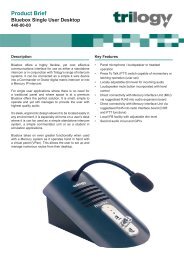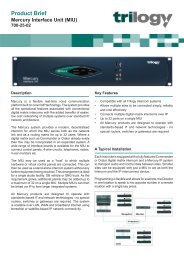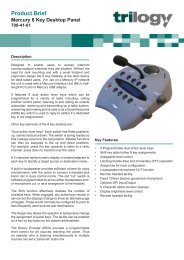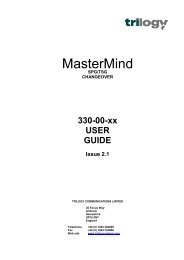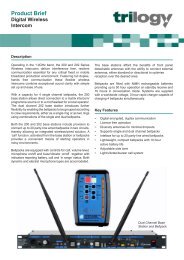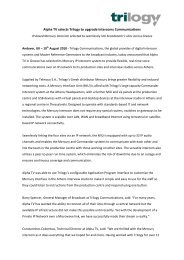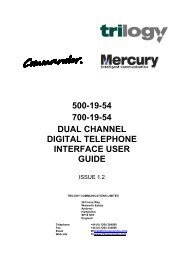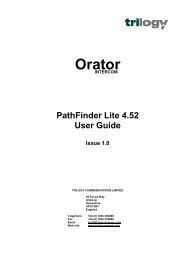PathFinder Software Configuration Guide - Trilogy Communications
PathFinder Software Configuration Guide - Trilogy Communications
PathFinder Software Configuration Guide - Trilogy Communications
- No tags were found...
Create successful ePaper yourself
Turn your PDF publications into a flip-book with our unique Google optimized e-Paper software.
10.1.1 Dimming - Additional Information<strong>PathFinder</strong> Version 4.22 User <strong>Guide</strong>Most situations are catered for adequately by mirror dimming. Generally it is advised that allpanels are given a dim level of somewhere between -9dB and -25dB - this is a trade offbetween howl-round prevention and level reduction and must be determined empirically.Note that <strong>PathFinder</strong> will, by default, set a dim level of –25dB for all ports.Mirror dimming caters for the normal scenario where panel A is connected to panel B, andvice versa. This will cause an immediate feedback loop and howl-round. The software canautomatically detect this situation and apply attenuation to the offending crosspoints.The most complex aspect of dimming is the use of special dim groups. These are providedto cater for the scenario where no obvious feedback path exists - and which the softwarecannot therefore predict.A typical example might be two panels in close physical proximity when there are two furtherremote panels, each in completely different location both to themselves and the two closecoupledpanels. Feedback can occur in this typical scenario, depicted below with the tworemote panels as R1 and R2 and the two close-coupled panels as CC1 and CC2.• Remote panel R1 is speaking to panel CC1• Close-coupled panel CC2 is speaking to R2• R2 is speaking to R1Audio from R1 appears at the loudspeaker of CC1, and will be picked up by the microphoneof panel CC2. Since CC2 is speaking to R2, the audio therefore appears at the loudspeakerof panel R2 to be picked up by R2’s microphone. Since R2 is speaking R1, the acousticloop is completed and howl-round occurs.Panel CC1Panel R1, speaking to CC1FEEDBACK!Panel CC2 speaking to R2.Due to acoustic coupling to CC1, Audiofrom CC1 is also picked up by this paneland received by R2.Panel R2, speaking to R1.This panel received audio directfrom CC2, plus coupled audiofrom CC1, which is from R1,which is from this panel.The software cannot predict this, and the exact solution depends on the operationalrequirements of the installation.In principle, the solution is to use (for example) the action of panel R2 speaking to R1 toautomatically trigger dimming of the route from R1 to CC1.This is implemented by accessing the dimming form for panel R1. R2 will be shown as apotential source to R1; in the dim group column enter group 1.Edit group 1 and add the crosspoint with R1 as the source and CC1 as the destination.When R2 speaks to R1, the dim factor set-up for panel CC1 will attenuate the route from R1to CC1.Page 64 of 64 Issue 1 <strong>Trilogy</strong> <strong>Communications</strong> Limited




